
Nepeta: 6 Successful Companion Planting Ideas
6 successful pairing ideas
Contents
Nepeta, also known as Catmint or Catnip, is a beautiful perennial that offers a long summer flowering period, with blue or mauve flower spikes. Its aromatic leaves are appreciated by cats, and the dried leaves can also be used in herbal tea for their anti-stress and digestive properties. It thrives in full sun, in well-draining soil that does not retain too much moisture in winter. Nepeta is well-suited to dry gardens, rockeries, and Mediterranean-style gardens, but it also fits nicely in mixed borders or even in pots on the terrace. With its style similar to lavender, it is ideal for replacing it in cool, damp regions. Discover our finest ideas and inspirations for incorporating it into your garden.
In a romantic garden
Create a soft and romantic atmosphere by pairing nepeta with the refined flowering of roses. Indeed, nepeta is perfect for dressing the often bare bases of roses without overshadowing their blooms. For colours, design a garden in soft shades, particularly pinks and mauves. Consider the charming little star-shaped flowers of astrantias, the elegant flowers of foxgloves, and the airy flowering of paniculate gypsophila. Discover the lovely soft pink flowers, in upright clusters, of Verbascum ‘Sugar Plum’. Don’t hesitate to add depth with a few touches of bright or dark red, for example by choosing the rose ‘Darcey Bussel’ or ‘Ingrid Bergman’.
Cleomes will also find their place in this style of garden: we appreciate their graceful, very light flowers, equipped with long protruding stamens that give them a tousled appearance. A few silver notes will beautifully complement these soft and romantic blooms: enjoy, for instance, the foliage of wormwoods, Stachys byzantina, or Salvia argentea. As for shrubs, consider the lovely flowering of Deutzia setchuenensis ‘Corymbiflora’, as well as Japanese spireas.
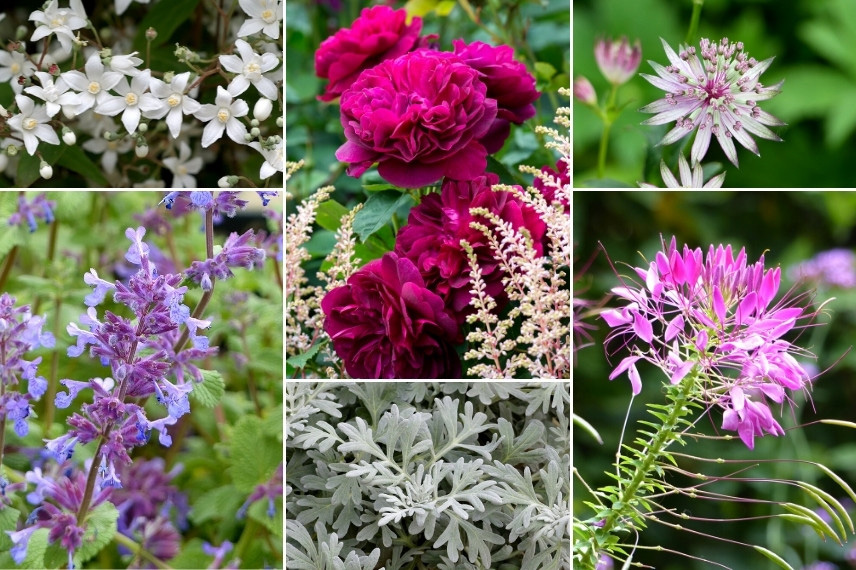
Deutzia setchuenensis ‘Corymbiflora’, David Austin rose ‘Darcey Bussel’, Astrantia major ‘Ruby Star’, Nepeta racemosa ‘Grog’, Artemisia stelleriana ‘Silver Brocade’, and Cleome ‘Violet Queen’
In a cottage garden
With its beautiful mauve-blue flowering, nepeta is ideal for creating a cottage garden. This typically English garden style is perfect for showcasing beautiful stone houses. In front of the house, you can create abundant beds with irregular shapes overflowing with a multitude of flowers and foliage. For the flowering plants, choose soft, pastel shades: particularly light blue and white, but also mauve, soft pink, or apricot.
We recommend incorporating, for example, clematis, campanula, platycodon, foxgloves, salvias, and delphiniums. Also consider ornamental Alliums, such as Allium giganteum or Allium ‘White Cloud’. To create a lush and abundant effect, focus on the generous foliage of ferns, hostas, and the artichoke Cynara cardunculus.
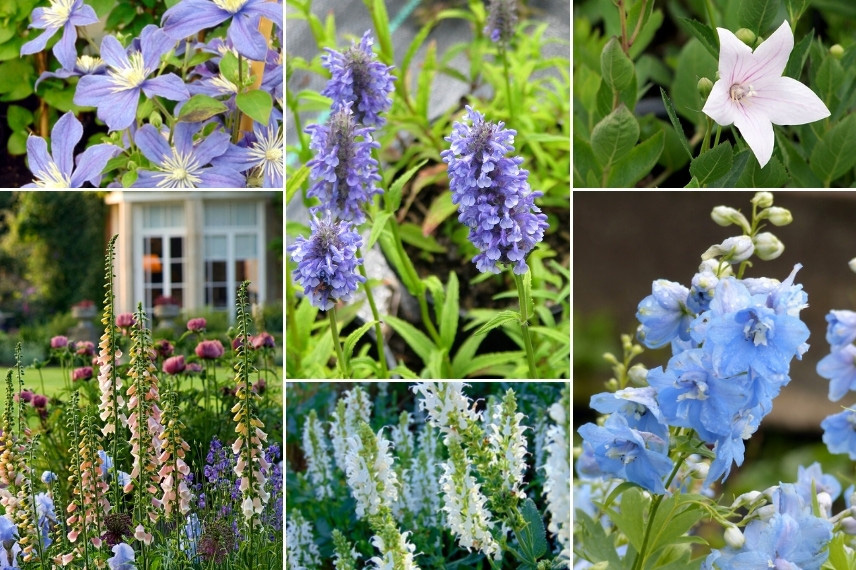
Clematis ‘Arabella’, Nepeta nervosa (photo L. Enking), Platycodon grandiflorus ‘Perlmutterschale’, Scene with foxgloves ‘Suttons Apricot’, Papaver orientale ‘Patty’s Plum’ and Iris ‘Jane Phillips’ (The Old Rectory, Haselbech – Photo Clive Nichols – MAP), Salvia nemorosa ‘Schneehügel’ and Delphinium ‘Pacific Summer Skies’
Discover other Nepeta - Catnip
View all →Available in 2 sizes
Available in 2 sizes
Available in 2 sizes
Available in 1 sizes
Available in 3 sizes
Available in 3 sizes
Available in 2 sizes
Available in 1 sizes
Available in 1 sizes
Available in 1 sizes
In a naturalistic garden
Nepeta, with its light spike flowering, will find its place in a less formal garden, with a natural and rustic style. Pair it with plants that have a free and flexible habit, and a delicate flowering. Consider, for example, Gaura lindheimeri, Buenos Aires verbena, Penstemon, and sanguisorbes. Integrate some grasses, such as Stipa gigantea or Stipa pennata: their light foliage and floral spikes will undulate in the wind. Discover the stunning white flowering of the Allium carinatum ssp. pulchellum ‘Album’.
You can create contrast by defining your flower beds with sharp borders, a perfectly mown lawn, or topiary bushes: this will frame these very free flowerings while highlighting their airy and wild silhouette.
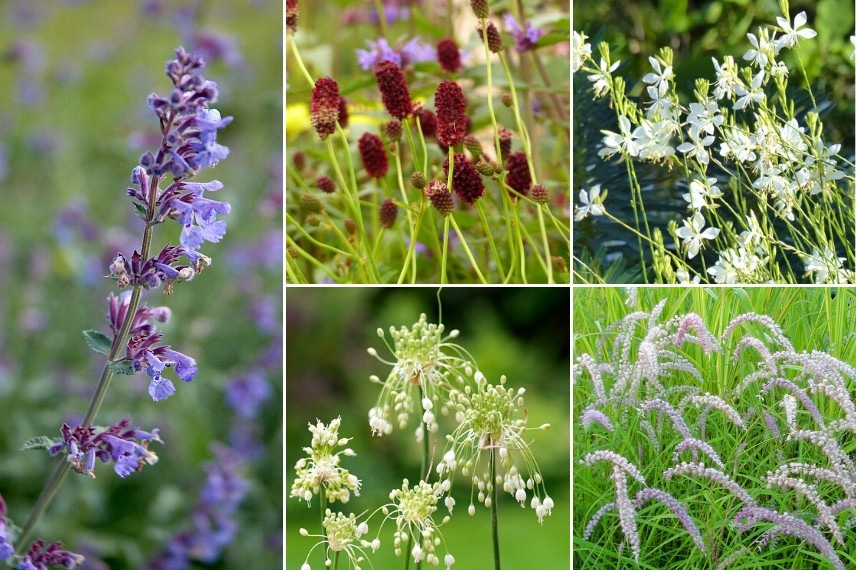
Nepeta faassenii ‘Six Hill’s Giant’, Sanguisorba ‘Red Thunder’, Gaura lindheimeri ‘Snowbird’, Allium carinatum ssp. pulchellum ‘Album’ (photo iBulb), Chinese fountain grass ‘Tall Tail’
Read also
15 plants for a sunny rockeryFor a Mediterranean atmosphere
Nepeta can replace lavender (or accompany it) in a Mediterranean-style garden. It will adapt easily, as it enjoys full sun and well-drained soils, even stony or sandy ones. Pair it with aromatic and fragrant plants, such as thyme, rosemary, santolina, and helichrysum… Consider Sea Holly (Eryngium maritimum), Corsican Spurge (Euphorbia myrsinites), and Agapanthus. Add a touch of exoticism with the majestic silhouette of agaves and Yucca filamentosa, as well as with Opuntias and some palms, like Chamaerops humilis. For shrubs, consider Anthyllis barba-jovis, oleanders, and strawberry trees, not forgetting, of course, the stunning silhouette of olive trees.
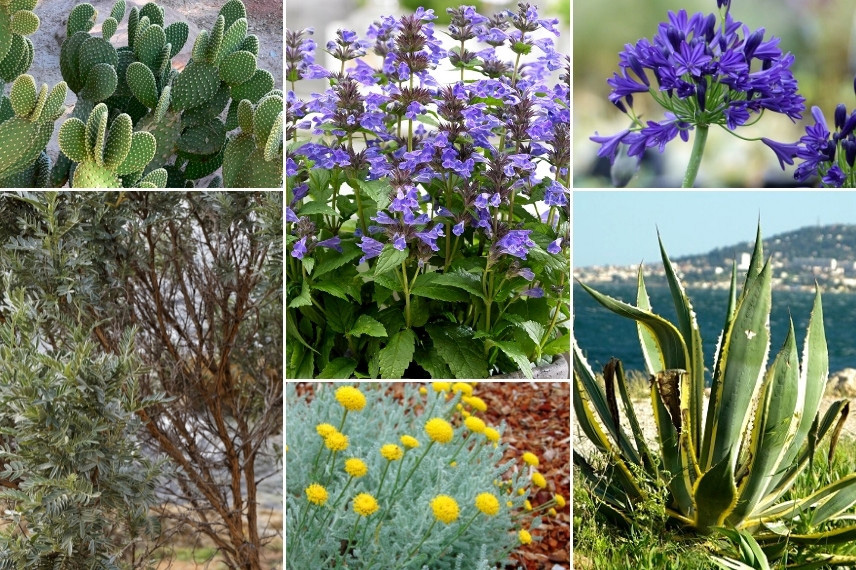
Opuntia microdasys, Nepeta ‘Neptune’, Agapanthus ‘Royal Velvet’, Anthyllis barba-jovis (photo Adobe Stock), Santolina chamaecyparissus, and Agave americana ‘Variegata’
In a dry garden or in a sunny rockery
Nepeta adapts to poor, dry, stony soils: you can easily incorporate it into a mineral-dominant garden or a sunny rockery. For example, pair it with red valerian (Centranthus ruber), as well as Erigeron karvinskianus, helianthemums, and garden catchfly, Lychnis coronaria. Integrate some small carpet plants, such as sedums, houseleeks, and Delosperma cooperi.
You can add lightness by planting grasses alongside them, such as Stipa tenuifolia, Festuca glauca, or Carex comans. Also consider Geranium cinereum and Campanula muralis.

Nepeta ‘Purrsian Blue’, Centranthus ruber, Erigeron karvinskianus (photo Robert Flogaus-Faust), Delosperma cooperi and Sempervivum arachnoideum (photo Kristine Paulus)
To play with complementary colours!
The best technique for achieving spectacular and harmonious flowerbeds in the garden is to focus on complementary colours. This involves pairing two shades that are opposite each other on the colour wheel. Since nepeta is blue, it is best to pair it with orange flowers. Enhance the blue hue of Nepeta by placing it alongside sages, delphiniums, polemoniums, agapanthus, campanulas, and hardy geraniums, then introduce contrast with orange blooms: daylilies, Echinacea ‘Big Kahuna’, yarrow ‘Terracotta’, Geum ‘Totally Tangerine’, Kniphofia ‘Alcazar’, Crocosmia…
If you are growing a variety of nepeta that flowers in a more violet-purple shade rather than blue, pair it with yellow flowers. Consider options like Coreopsis, Rudbeckia, Echinacea ‘Harvest Moon’, yarrow, and lupin ‘Gallery Yellow’…
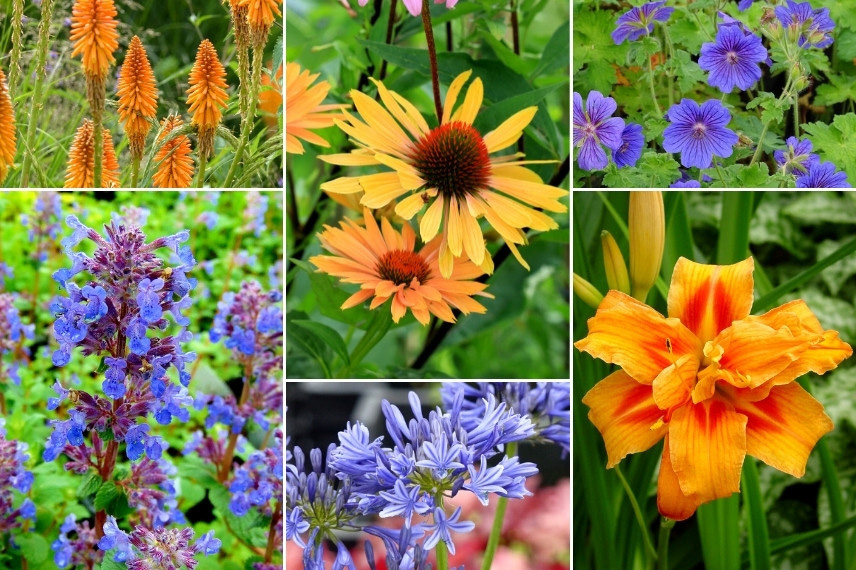
Kniphofia ‘Fiery Fred’, Echinacea ‘Big Kahuna’ (photo Adobe Stock), Geranium magnificum ‘Anemoneflorum’, Nepeta racemosa ‘Grog’, Agapanthus ‘Royal Velvet’, and Hemerocallis ‘Apricot Beauty’
- Subscribe!
- Contents
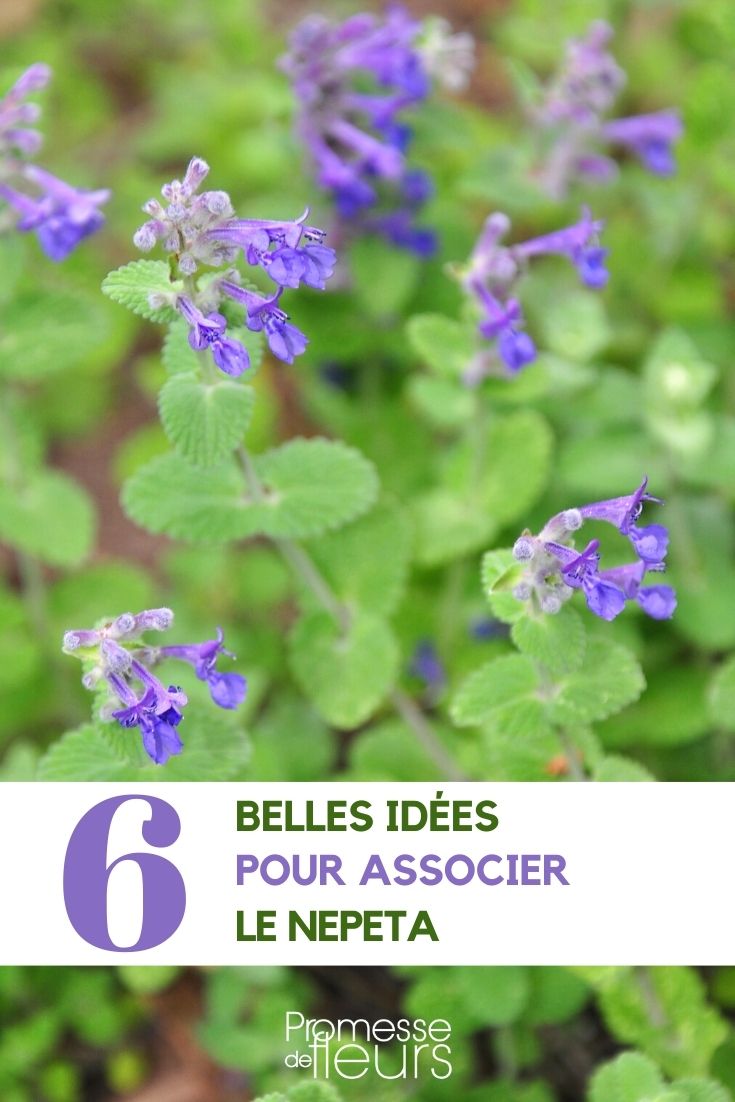































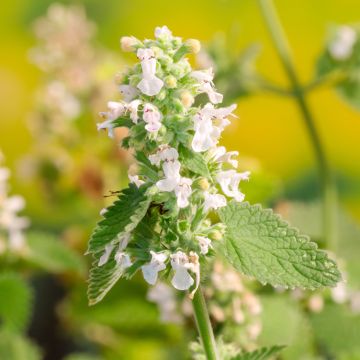
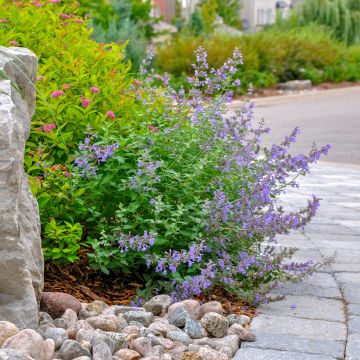

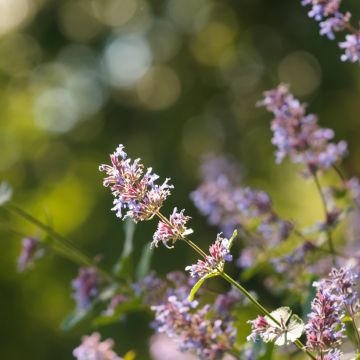
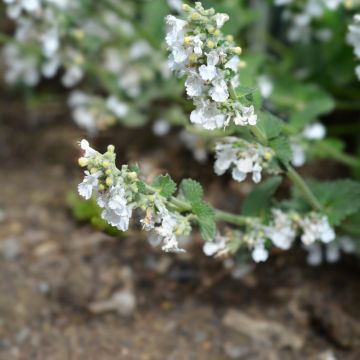

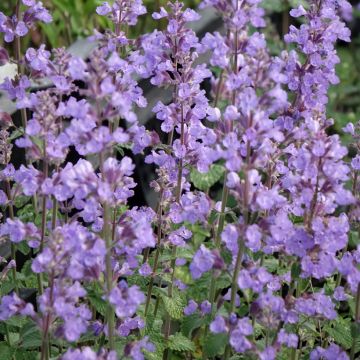
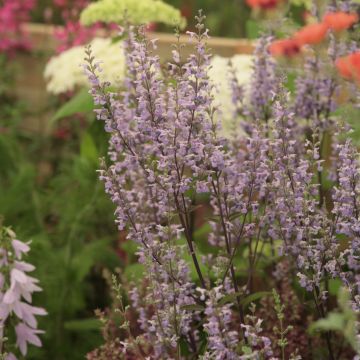


Comments